The comeback of crypto ETFs have caught the attention of investors

Thanks to their impressive performance this year, cryptocurrency ETFs are expected to be the best-performing category of exchange-traded funds by 2023.
According to a report from The Wall Street Journal, this is an improvement over the crypto meltdown of last year, which struck $1 trillion in value. The value of Bitcoin, the most popular cryptocurrency in the world, fell by 65% to $16,500 at year's conclusion. Bitcoin's price is up 72% this year to March 31, while Ethereum's value increased 52%.
“Investors are now reassessing crypto ETFs as the industry rebounds because they see long-term opportunity,” said Roxanna Islam, associate research director at VettaFi LLC, an ETF market-research firm. “They think the prices of bitcoin and crypto-related equities have bottomed out and now is a good time to participate in the future of this emerging marketplace.”
Leah Wald, chief executive officer of Valkyrie, a bitcoin investment-management group, said, “They are also encouraged by the increased regulatory scrutiny of the industry.”
Financial analysts suggest that additional macroeconomic reasons are also increasing investor confidence. Some investors believe the Federal Reserve is approaching the end of its rate-hike cycle, inflation is declining, and many consumers are shifting back to riskier assets.
There are 26 cryptocurrency ETFs with $1.89 billion in assets, the majority of which are equities crypto ETFs intended to give investors access to the digital currency market without having to purchase or store the underlying assets. Others invest in bitcoin futures, such the ProShares Bitcoin Strategy ETF (BITO).
With a return of 96% up to March 30 this year, the Valkyrie Bitcoin Miners ETF (WGMI) tops the U.S. blockchain ETF. It generates investments totaling at least 80% of its assets in firms whose income or earnings come from bitcoin mining activities at least 50% of the time.
For the same period, the total returns for the VanEck Digital Assets Mining ETF (DAM) were 81.5%.
Hashdex Bitcoin Futures ETF (DEFI) has generated a return of 68.7%. The first U.S. blockchain ETF was introduced in 2018, and investors considering putting in these funds should be aware that it is a fresh fund class. The BITO fund, the first U.S. futures-based ETF, became active in October 2021.
“It’s still an immature market still without a lot of regulatory oversight,” Islam says.
Bryan Armour, director of passive strategies research for North America at Morningstar, cautions, “Keep in mind these funds are highly volatile, and it’s extremely difficult to time the market.”
Although Morningstar Direct estimates that these funds have an average expense ratio of 0.72%, some have substantially greater costs. Financial advisors often encourage individual investors to keep no more than 1% to 5% of their holdings in tech stocks in these vehicles after taking all of these factors into account.
“Most of these ETFs are still underwater. The top-performing funds in 2023 declined by as much as 80% or more in 2022,” Armour said. “These small thematic funds have concentrated portfolios tied to the digital currency marketplace, so consider how much exposure you really want.”



